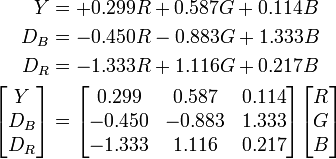YDbDr

 ,
,  and
and  components.
components.YDbDr, sometimes written YDBDR, is the colour space used in the SÉCAM analog terrestrial colour television broadcasting standard, which is used in France and some countries of the former Eastern Bloc. It is very close to YUV (PAL) and its related colour spaces such as YIQ (NTSC), YPbPr and YCbCr.
YDbDr is composed of three components -  ,
,  and
and  .
.  is the luminance,
is the luminance,  and
and  are the chrominance components, representing the red and blue colour differences.
are the chrominance components, representing the red and blue colour differences.
Formulas
The three component signals are created from an original RGB (red, green and blue) source. The weighted values of  ,
,  and
and  are added together to produce a single
are added together to produce a single  signal, representing the overall brightness, or luminance, of that spot. The
signal, representing the overall brightness, or luminance, of that spot. The  signal is then created by subtracting the
signal is then created by subtracting the  from the blue signal of the original RGB, and then scaling; and
from the blue signal of the original RGB, and then scaling; and  by subtracting the
by subtracting the  from the red, and then scaling by a different factor.
from the red, and then scaling by a different factor.
These formulae approximate the conversion between the RGB colour space and YDbDr.
From RGB to YDbDr:
From YDbDr to RGB:
You may note that the  component of YDbDr is the same as the
component of YDbDr is the same as the  component of YUV.
component of YUV.  and
and  are related to the
are related to the  and
and  components of the YUV colour space as follows:
components of the YUV colour space as follows:
There is also a variety of the PAL broadcasting standard, PAL-N, that uses the YDbDr colour space.
References
- Shi, Yun Q. and Sun, Huifang Image and Video Compression for Multimedia Engineering, CRC Press, 2000 ISBN 0-8493-3491-8
See also
- YUV - related colour system
- PAL#Technical details - some information on PAL-N
| ||||||||||||||||||||||||||||||
![\begin{align}
R, G, B, Y &\in \left[ 0, 1 \right]\\
D_B, D_R &\in \left[ -1.333, 1.333 \right]\end{align}](../I/m/5bedf75c2402fc5648ae200aee2758b7.png)


